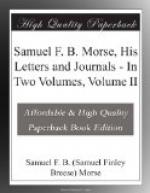“He was a lover of simple, unaffected truth, and this trait is shown in his works as an artist. He had a passion for color, and rich, harmonious tints run through his pictures, which are glowing and mellow, and yet pearly and delicate.
“He had a true painter’s eye, but he was hindered from reaching the fame his genius promised as a painter by various distractions, such as the early battles of the Academy of Design in its struggles for life, domestic afflictions, and, more than all, the engrossing cares of his invention.
[Illustration: SUSAN MORSE Eldest daughter of the artist.]
“The ‘Hercules,’ with its colossal proportions and daring attitude, is evidence of the zeal and courage of his early studies.... It is worthy of being carefully preserved in a public gallery, not only as an instance of successful study in a young artist (Morse was in his twenty-first year), but as possessing high artistic merit, and a force and richness which plainly show that, if his energies had not been diverted, he might have achieved a name in art equal to the greatest of his contemporaries....
“Professor Morse’s world-wide fame rests, of course, on his invention of the electric telegraph; but it should be remembered that the qualities of mind which led to it were developed in the progress of his art studies, and if his paintings, in the various fields of history, portrait, and landscape, could be brought together, it would be found that he deserved an honored place among the foremost American artists.”
This was an estimate of Morse’s ability as a painter by a man of his own day, a friend and pupil. As this would, naturally, be somewhat biased, it will be more to the point to see what a competent critic of the present day has to say.
Mr. Samuel Isham, in his authoritative “History of American Painting,” published in 1910, after giving a brief biographical sketch of Morse and telling why he came to abandon the brush, thus sums up:—
“It was a serious loss, for Morse, without being a genius, was yet, perhaps, better calculated than another to give in pictures the spirit of the difficult times from 1830 to 1860. He was a man sound in mind and body, well born, well educated, and both by birth and education in sympathy with his time. He had been abroad, had seen good work, and received sound training. His ideals were not too far ahead of his public. Working as he did under widely varying conditions, his paintings are dissimilar, not only in merit but in method of execution; even his portraits vary from thin, free handling to solid impasto. Yet in the best of them there is a real painter’s feeling for his material; the heads have a soundness of construction and a freshness in the carnations that recall Raeburn rather than West; the poses are graceful or interesting, the costumes are skilfully arranged, and in addition he understands perfectly the character of his sitters, the men and women of the transition period, shrewd, capable, but rather commonplace, without the ponderous dignity of Copley’s subjects or the cosmopolitan graces of a later day.




